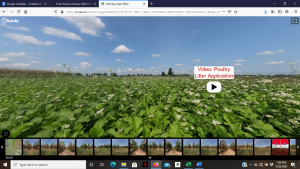Agronomy, Homepage Slider, Water Quality
2020 Farm Science Review Virtual Research Plot Tour Continued – Poultry Litter Use
By Dusty Sonnenberg, CCA, Ohio Field Leader: a project of the Ohio Soybean Council and soybean checkoff.
The OSU Extension, Agronomic Crops Team and the e-Fields Program had a number of research plots once again at the Molly Caren Agricultural Center in 2020. The on-line review gave guests a number of opportunities to take a virtual plot tour and learn more about the ongoing research. The virtual plot tour was sponsored by the Ohio Soybean Council.
The use of poultry litter as a source of nutrients in crop production has increased in recent years as farmers have realized the additional benefits it brings in the micro-nutrients and biological components it contains. In order to maximize these benefits, proper application is necessary. Proper application includes calibrating the spreader in order to apply the correct amount to achieve the desired agronomic results while still protecting the environment.
As part of the 2020 Farm Science Review Virtual Plot Tour, a session was held on Soil manure spreader calibration and poultry litter application. To properly calibrate the spreader, a demonstration was done using a 56” x 56” tarp placed in the field. The tarp captured the poultry litter as it was applied. The litter on the tarp was then weighed. This number is used to calculate the application rate in tons per acre. The number of pounds of litter on the 56”x56” tarp equates to the number of tons applied per acre applied to the field. The opening of the gate on the spreader, and the ground speed can be adjusted accordingly to adjust the rate of litter being applied per acre.
As another part of the plot tour, Tom Pendleton, with Innovative Ag Management gave a brief presentation about poultry litter use on farms. “Farmers should be aware that there are differences in poultry litter,” said Pendleton. “Litter from broilers may have bedding in it. The material from layers is pure a manure containing: Nitrogen, Phosphorus, Potassium, Calcium, Zinc, and Sulfur. It also has about the equivalent of 100 pounds of high calcium lime per ton. It can be used on most all crops, including: corn, wheat, and even soybeans back to soybeans,” said Pendleton.
Poultry litter is an organic product, and with it come many benefits. “The nutrients are in a plant available form immediately, said Pendleton. “When it comes directly from the birds it is already mineralized, so it is ready to go. For the most part, the nutrient content of poultry litter stays the same from a barn because the poultry farm feed rations don’t really change, although every scoop of litter is slightly different. The greatest difference is in the moisture content. The drier the product, the higher the nutrient content.”
Weather is always a factor in production agriculture, and the application of poultry litter is equally impacted by rain in the forecast. “The biggest challenge is weather conditions,” said Pendleton. “The last year to year and a half, the wet weather impacts the product and ability to get out and spread it. We encourage farmers to follow the spreader with a tillage tool. The law says within 24 hours, poultry litter should be incorporated.”